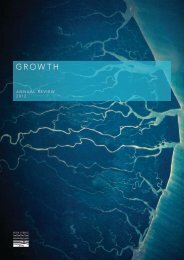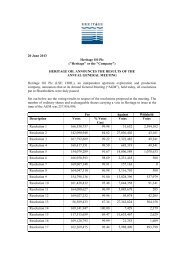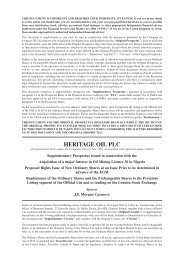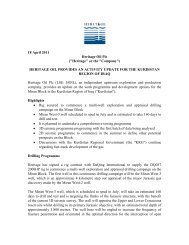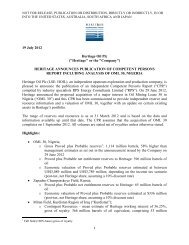Prospectus re Admission to the Official List - Heritage Oil
Prospectus re Admission to the Official List - Heritage Oil
Prospectus re Admission to the Official List - Heritage Oil
Create successful ePaper yourself
Turn your PDF publications into a flip-book with our unique Google optimized e-Paper software.
RPS Energy<strong>Heritage</strong> <strong>Oil</strong> – Competent Persons ReportFigu<strong>re</strong> 10: West Bukha 3D inline 112226FEB200822314633The Opera<strong>to</strong>r maps a<strong>re</strong> based on a mo<strong>re</strong> simplistic approach <strong>to</strong> depth conversion than in p<strong>re</strong>vious studies,which used a complex interval velocity method for depth conversion as shallow salt was thought <strong>to</strong> impac<strong>to</strong>n velocities. Despite this approach West Bukha-2 penetrated <strong>the</strong> <strong>re</strong>servoir some 80 m shallower thanp<strong>re</strong>dicted which invalidated this method. The cur<strong>re</strong>nt maps a<strong>re</strong> based on an average velocities for eachhorizon derived from well data. The<strong>re</strong> is little variation in average velocities across <strong>the</strong> field, although aneastward dec<strong>re</strong>ase in average velocity is not supported by well data and velocities at <strong>the</strong> ext<strong>re</strong>me west andeast of <strong>the</strong> model exceed <strong>the</strong> velocities in <strong>the</strong> wells although not markedly. RPS considers <strong>the</strong> depthconversion <strong>re</strong>asonable.A facies model has been developed by <strong>the</strong> Opera<strong>to</strong>r which has been <strong>re</strong>viewed by RPS and appears<strong>re</strong>asonable. The Mauddud shows little variation in thickness across <strong>the</strong> field and <strong>the</strong> subunits a<strong>re</strong> <strong>the</strong> samein all wells drilled in <strong>the</strong> field. All nine sub units across <strong>the</strong> field a<strong>re</strong> carbonate platform facies. Cor<strong>re</strong>lationwith <strong>the</strong> Bukha filed shows that Mauddud sub-units 7, 8 and 9 a<strong>re</strong> missing in Bukha which indicates <strong>the</strong>position of <strong>the</strong> shelf is between West Bukha and Bukha. Cor<strong>re</strong>lation with Bukha and Tibat shows aback-stepping carbonate platform from <strong>the</strong> south east <strong>to</strong> north west during deposition of <strong>the</strong> Mauddud.Each well in <strong>the</strong> West Bukha Field has <strong>the</strong> same Mauddud sub-units, suggesting that West Bukha is <strong>the</strong>final carbonate platform and hence has a complete Mauddud section.The Mishrif varies considerably in thickness across <strong>the</strong> field with 3 sub- units p<strong>re</strong>sent at West Bukha-2 andHenjam-1, whe<strong>re</strong>as West Bukha-1 and Khasab-1 have only <strong>the</strong> deepest Mishrif-1 sub- unit. The Henjam-1and West Bukha-2 wells a<strong>re</strong> interp<strong>re</strong>ted <strong>to</strong> be on <strong>the</strong> carbonate platform during Mishrif deposition withWest Bukha-1 and Khasab-1 existing on <strong>the</strong> carbonate slope. <strong>Heritage</strong> has used an isopach thickness map<strong>to</strong> determine <strong>the</strong> extent of <strong>the</strong> platform and <strong>the</strong> position of <strong>the</strong> slope. This is a <strong>re</strong>asonable approach asvariation in <strong>the</strong> thickness of <strong>the</strong> Mishrif is <strong>the</strong> p<strong>re</strong>dominant variable in <strong>the</strong> thickness of <strong>the</strong> Ilam-Nahr Umrisopach that was used <strong>to</strong> define <strong>the</strong> platform. This thickness variation is also visible on <strong>the</strong> seismic whe<strong>re</strong> asingle trough across <strong>the</strong> field at <strong>the</strong> Top Ilam becomes a trough-peak-trough <strong>to</strong> <strong>the</strong> north. Reservoir qualityand thickness a<strong>re</strong> interp<strong>re</strong>ted <strong>to</strong> improve <strong>to</strong> <strong>the</strong> north whe<strong>re</strong> <strong>the</strong> Mishrif is thickest. If this is <strong>the</strong> case, wellsdrilled <strong>to</strong> <strong>the</strong> SW of West Bukha-2 a<strong>re</strong> unlikely <strong>to</strong> encounter <strong>the</strong> better carbonate platform facies and <strong>the</strong><strong>re</strong>servoir will be similar <strong>to</strong> West Bukha-1.3.3.3. In Place VolumesRPS calculated in place volumes for <strong>the</strong> Mishrif/Mauddud and for <strong>the</strong> Thamama.85



